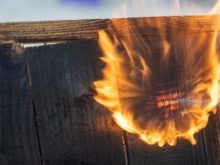Reaction to Fire performance of wood-based panels
Reaction to Fire performance
Reaction to Fire means the "response of a product in contributing by its own decomposition to a fire to which it is exposed".
Among the different Standards, the UNI CEI EN ISO 13943 Standard defines the terminologies used in the field of fire safety. The UNI EN 13501-1 Standard, on the other hand, aims to classify the material according to the Reaction to Fire performance, providing a common classification for the whole European market.
Also, there are rules that regulate and classify construction materials at a national level, such as the Italian D.M. 26/06/84 (and subsequent changes) that attributes the values from 0 to 5 according to the Reaction to Fire performance, or the French Standard (the NF P92-507). Here, we will analyse the European Standard and how semi-finished products can be classified.
The European Reaction to Fire Classification provides a shrewd system of tests in order to analyze the effective response of the material to a possible fire. As a result of the tests, it can be approved by National and European certification Institutes.
The UNI EN 13501 Standard
The European Standard provides for a common method classifying the Reaction to Fire performance of construction materials (such as chipboard and plywood panels) on the basis of their use.
Products classified in A1 and A2 Euroclasses are non-combustible. On the other hand, construction products can be classified in:
- B Euroclass: combustible material but with very limited contribution to fire,
- C Euroclass: combustible material but with limited contribution to fire,
- D Euroclass, with medium contribution to fire,
- E and F Euroclasses, for highly/easily contribution to fire.
For the A2, B, C and D Reaction to Fire classes, the European Standard provides additional tests to define:
- the smoke release intensity ("s", for smoke: there are 3 levels of intensity),
- burning Droplets ("d", for flaming droplets: values range from 0 to 2).
They both are important issues directly related to the Reaction to Fire issue.
Flame retardants for wood-based panels
Fire prevention is always a topic of great importance: in KALI division, through an in-depth study path (here you can read the interview with the Head of R&D Dept.), we are able to supply additives to be used during the panels production process that can help delay the birth of the flame.
The division, more specifically, has specialized in the production of flame retardants in different particle size distribution, to help make semi-finished product with very limited contribution to fire.
The use of MG 20-13 product is strategic in terms of quality and performance of the semi-finished product: applying it in the production phase contribute to obtain the highest Reaction to Fire classes, in reference to the Italian, French and European regulations.
Contact us for more information about our flame retardants performance.

